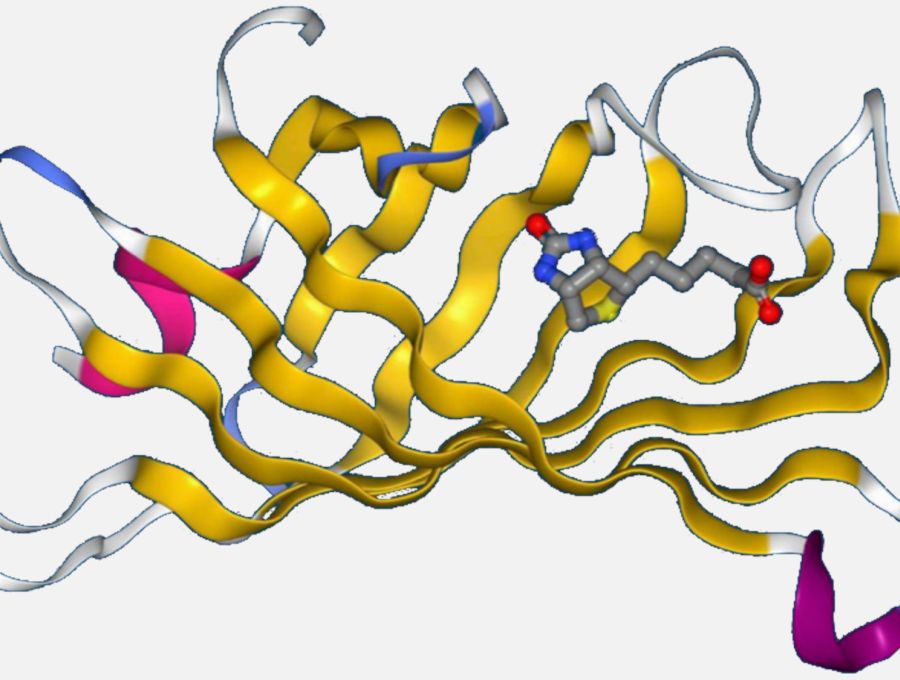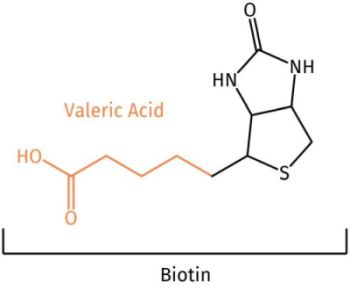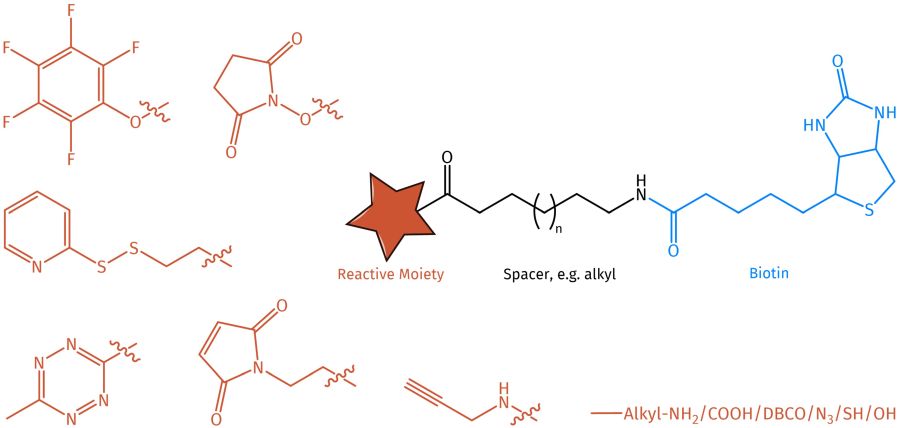Welcome to Iris Biotech
For better service please confirm your country and language we detected.

For better service please confirm your country and language we detected.

Thank you very much for your interest in our products. All prices listed on our website are ex-works, Germany, and may attract customs duties when imported.
You may/will be contacted by the shipping company for additional documentation that may be required by the US Customs for clearance.
We offer you the convenience of buying through a local partner, Peptide Solutions LLC who can import the shipment as well as prepay the customs duties and brokerage on your behalf and provide the convenience of a domestic sale.
Continue to Iris Biotech GmbHSend request to US distributorPublished on 10.08.2021

Biotinylation describes the attachment of biotin to a protein or other macromolecules. The selective “isolation” of such biotin-containing molecules out of complex mixtures is based on the high affinity of avidin for biotin, representing one of the strongest known non-covalent interactions between protein and ligand (Ka = 1015 M-1) and being unaffected by extremes in pH, temperature, organic solvents, or other denaturing agents. Furthermore, biotin is a rather small molecule compared to other labels minimalizing its steric impact on biotinylated target itself. Thus, this nonradioactive method represents a highly important and versatile tool for purification, immobilization, and labeling.

Chemical structure of biotin. Valeric acid moiety highlighted in orange.
As biotin bears a valeric acid side chain, it can easily be derivatized without affecting its avidin-binding site. Iris Biotech offers a broad portfolio of biotinylation reagents reactive towards various functional groups, e.g. primary amines, sulfhydryls and carboxyls, as well as derivatives with various linker lengths to adjust the availability of biotin for avidin binding, with incorporated PEG moieties for improved solubility or even with cleavable conjugates or for reversible biotinylation. This range of possibilities allows to perfectly suit the biotinylation reagent for the required application.

Illustration of exemplary biotinylation reagents with various functional groups and spacer lengths.
Within the following, we are presenting a selection of Biotin-derivatives and applications available in our portfolio. However, if you are looking for a special derivative not listed, please visit our Webshop or get in contact for a custom synthesis.
Reversible Biotinylation
In some cases, reversible biotin-mediated binding is desired. Therefore, we offer biotinylating variants with cleavable linkers based on disulfides, which can be cleaved using reducing agents such as glutathione or by reducing conditions inside certain cell compartments, thus enabling specific elution of biotinylated molecules from biotin-binding proteins (e.g. LS-4240, LS-4230). Another alternative for reversible binding to streptavidin is the less strongly binding biotin analogue desthiobiotin (LS-1660, LS-1650).
PEG Containing Biotinylation Reagents
PEGs have a dramatic impact on protein solubility, stability, and aggregation. Some protein biotin conjugates are particularly susceptible to aggregation and loss of antigen binding ability, which can complicate assays and provide irreproducible and/or erroneous results.
Reagents for Tyrosine-/Protein-Biotinylation
Tyramine compounds are converted to highly reactive radicals by horseradish peroxidase in presence of H2O2. In vicinity of proteins, these radicals preferentially react with surface exposed tyrosines. Therefore, biotin tyramide (LS-3500) is a perfect reagent for protein biotinylation. Besides, our portfolio includes various linked biotin tyramide derivatives (see related products) as well as biotin-aniline (LS-3970) suitable for APEX2-mediated RNA labeling.
Amine Reactive Biotinylation Reagents
Active esters such as N-hydroxysuccinimide (NHS) esters permit a catalyst-free conjugation reaction to amines, e.g. of lysine side chains and the N-terminus, under mild conditions. Yet, NHS esters may hydrolyze over time if, for example, atmospheric moisture has condensed on the substance. As alternatives, tetrafluorophenyl (TFP) and pentafluorophenyl (PFP) active esters can be applied that are much more resistant to spontaneous hydrolysis.
Sulfhydryl Reactive Biotinylation Reagents
Besides amines, sulfhydryl groups of cysteines are the second most-common targets for biotinylation. Maleimide groups are highly reactive towards sulfhydryl groups at acidic to neutral pH. Furthermore, Iris Biotech offers pyridyl disulfide substituted biotin derivatives resulting in the formation of a cleavable disulfide bond. In addition, the biotinylation reaction can be monitored by the release of pyridine-2-thione.
Click Reactive Biotinylation Reagents
Our portfolio includes azide as well as alkyne derivatized biotins suitable for conjugation via Click chemistry. As further benefit triazole-linked adducts are shown to be highly resistant to the ubiquitous hydrolytic enzyme biotinidase and to bind avidin with dissociation constants in the low pM range.
Carboxy Reactive Biotinylation Reagents
Carboxy groups are present on aspartate and glutamate side chains as well as on the carboxy-terminal ends and can be reacted with amino-bearing biotinylation reagents in the presence of a coupling reagent, e.g. EDC.
➔ You want more information on biotinylation? Check out our booklet or see all biotin-products available in our webshop.
References:
Quantitative Analytical Method for the Determination of Biotinidase Activity in Dried Blood Spot Samples; E. Szabó, I. Szatmári, L. Szõnyi, Z. Takáts; Anal. Chem. 2015; 87(20): 10573-10578. https://doi.org/10.1021/acs.analchem.5b02996.
Triazole biotin: a tight-binding biotinidase-resistant conjugate; A. I. Germeroth, J. R. Hanna, R. Karim, F. Kundel, J. Lowther, P. G. N. Neate, E. A. Blackburn, M. A. Wear, D. J. Campopiano, A. N. Hulme; Org. Biomol. Chem. 2013; 11: 7700-7704. https://doi.org/10.1039/C3OB41837E.
Design and Synthesis of ATP-Based Nucleotide Analogues and Profiling of Nucleotide-Binding Proteins; J. C. Wolters, G. Roelfes, B. Poolman; Bioconjugate Chem. 2011; 22(7): 1345-1353. https://doi.org/10.1021/bc100592q.
Biotinyl-methyl 4-(amidomethyl) benzoate is a competitive inhibitor of human biotinidase; K. A. Kobza, K. Chai, G. Sarath, J. M. Takacs, J. Zempleni; J. Nutr. Biochem. 2008; 19(2): 826-832. https://doi.org/10.1016/j.jnutbio.2007.11.002.
Qualitative colorimetric ultramicroassay for the detection of biotinidase deficiency in newborns; E. C. González, N. Marrero, A. Frómeta, D. Herrera, E. Castells, P. L. Pérez; Clin. Chim. Acta 2006; 369(1): 35-39. https://doi.org/10.1016/j.cca.2006.01.009.
Artificial Metalloenzymes: (Strept)avidin as Host for Enantioselective Hydrogenation by Achiral Biotinylated Rhodium-Diphosphine Complexes; M. Skander, N. Humbert, J. collot, J. Gradinaru, G. Klein, A. Loosli, J. Sauser, A. Zocchi, F. Gilardoni, T. R. Ward; J. Am. Chem. Soc. 2004; 126(44): 14411-14418. https://doi.org/10.1021/ja0476718.
Purification and characterization of human serum biotinidase; J. Chauhan, K. Dakshinamurti; J. Biol. Chem. 1986; 261(9): 4268-4275. https://doi.org/10.1016/S0021-9258(17)35656-9.
Site-specific protein modification through Cu(I)-catalyzed 1,2,3-triazole formation and its implementation in protein microarray fabrication; P.-C. Lin, S.-H. Ueng, M.-C. Tseng, J.-L. Ko, K.-T. Huang, S.-C. Yu, A. K. Adak, Y.-J. Chen, C.-C. Lin; Angew. Chem. Int. Ed. Engl. 2006; 45(26): 4286-4290. https://doi.org/10.1002/anie.200600756.
Proximity-dependent labeling methods for proteomic profiling in living cells; C. L. Chen and N. Perrimon; Wiley Interdiscip Rev Dev Biol 2017; 6: e272. https://doi.org/10.1002/wdev.272.
Tyramide signal amplification for analysis of kinase activity by intracellular flow cytometry; M. R. Clutter, G. C. Heffner, P. O. Krutzik, K. L. Sachen and G. P. Nolan; Cytometry A 2010; 77: 1020-31. https://doi.org/10.1002/cyto.a.20970.
Expanding APEX2 Substrates for Spatial-specific Labeling of Nucleic Acids and Proteins in Living Cells; Y. Zhou, G. Wang, P. Wang, Z. Li, T. Yue, J. Wang, P. Zou; Angew. Chem. Int. Ed. 2019; 58(34): 1763-11767. https://doi.org/10.1002/anie.201905949.
Spatiotemporal profiling of cytosolic signaling complexes in living cells by selective proximity proteomics; M. Ke, X. Yuan, A. He, P. Yu, W. Chen, Y. Shi, T. Hunter, P. Zou, R. Tian; Nat. Commun. 2021; 12: 71. https://doi.org/10.1038/s41467-020-20367-x.
Mapping spatial transcriptome with light-activated proximity-dependent RNA labeling; P. Wang, W. Tang, Z. Li, Z. Zou, Y. Zhou, R. Li, T. Xion, J. Wang, P. Zou; Nat. Chem. Biol. 2019; 15(11): 1110-1119. https://doi.org/10.1038/s41589-019-0368-5.
Fabrication and characterization of heparin functionalized membrane-mimetic assemblies; P.-Y. Tseng, S. M. Rele, X.-L. Sun, E. L. Chaikof; Biomaterials 2006; 27(12): 2627-2636. https://doi.org/10.1016/j.biomaterials.2005.10.032.
Quantification of streptavidin adsorption in microtitration wells; L. Välimaa, K. Pettersson, J. Rosenberg, M. Karp, T. Lövgren; Anal. Biochem. 2004; 331(2): 376-384. https://doi.org/10.1016/j.ab.2004.04.003.